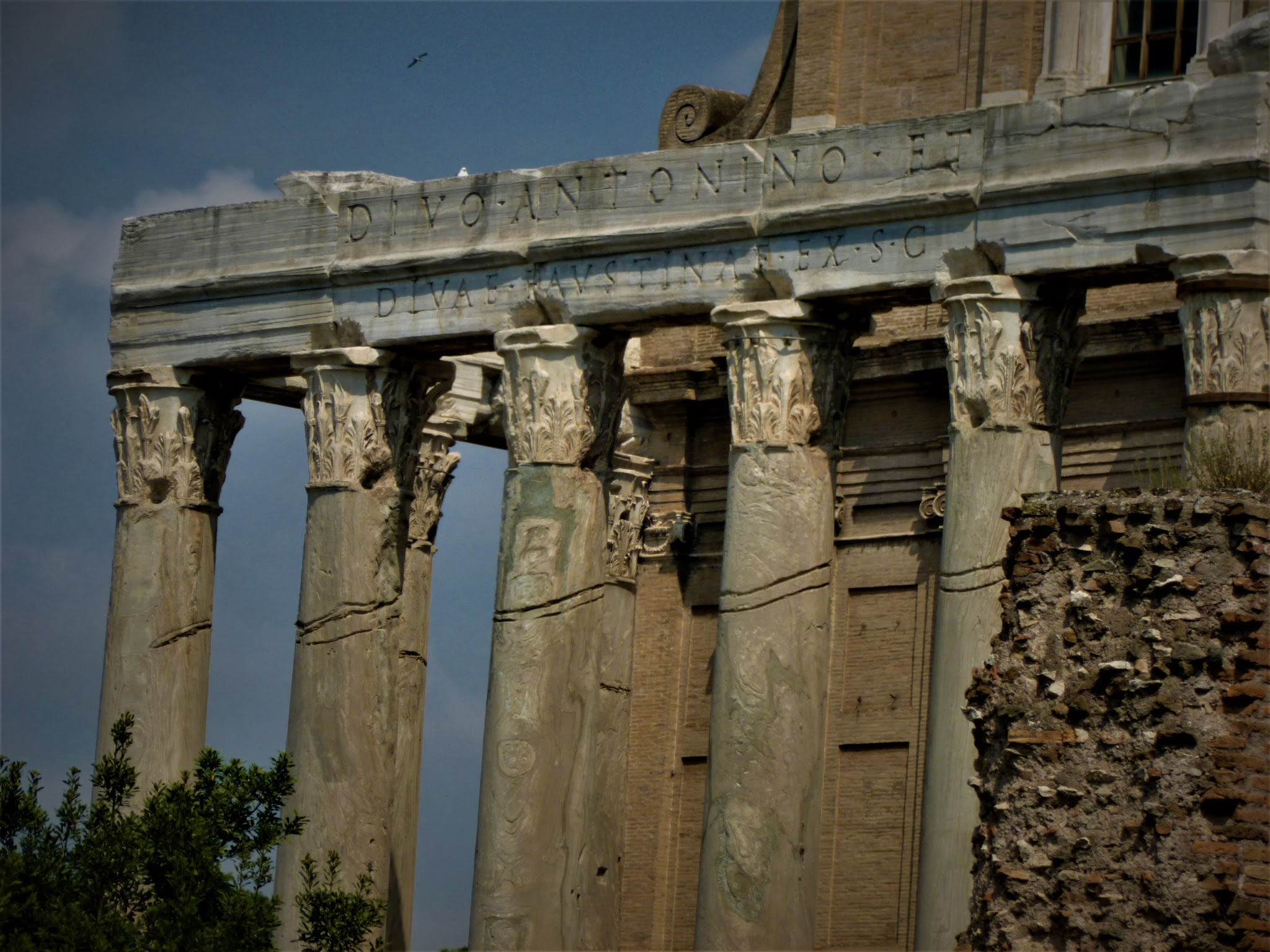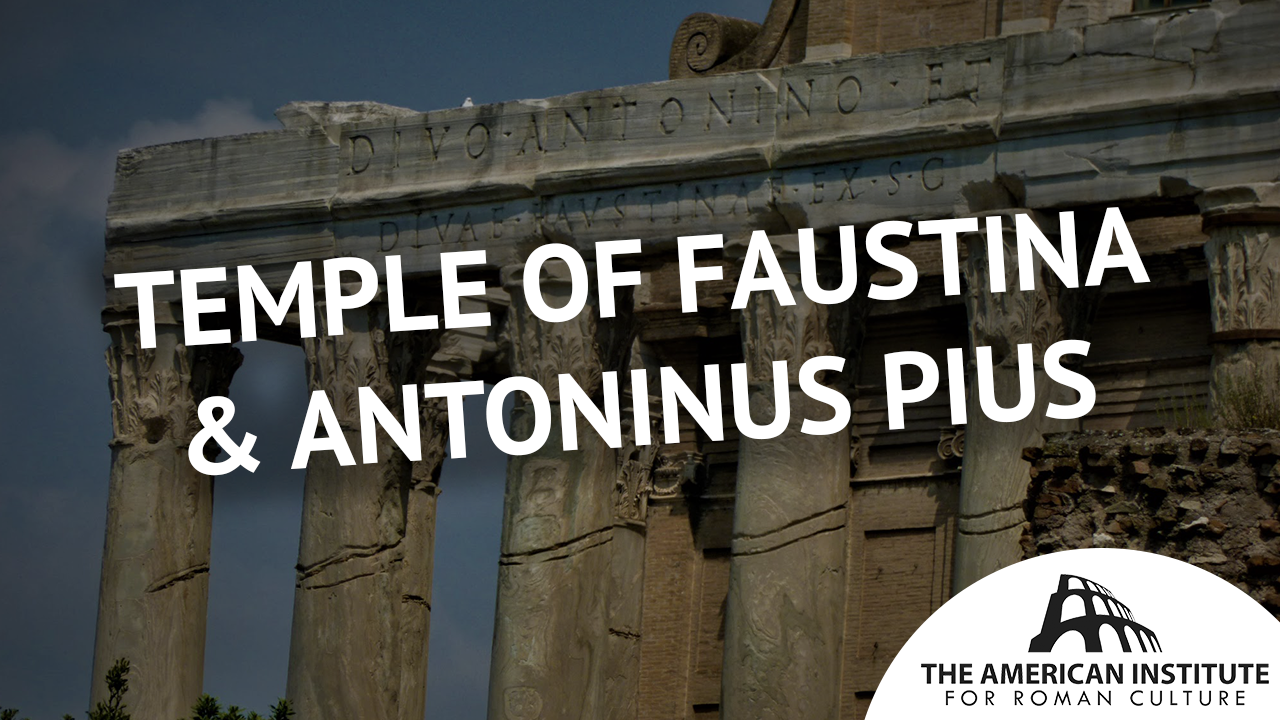Start with our video overview:
The Temple of Faustina and Antoninus Pius is one of the best-preserved buildings in the Roman Forum. Antoninus Pius was emperor of the Roman Empire from 138 to his death in 161 CE. He ordered the construction of the temple following the early death of his beloved wife, Faustina the Elder, in 140 CE.
Antoninus died more than 20 years after Faustina, in 161 CE. Upon his death, the Senate issued a decree to rename the temple to celebrate them both together. This alteration is visible on the dedication inscriptions engraved on the facade: first “DIVAE FAVSTINA” and on top of that, a later addition, “DIVO ANTONINO”
Augusta Faustina, the solemn title reserved for the Roman Empresses, was consecrated after her death. Not only was her temple erected in the Forum, but she was also worshiped by a designated priesthood, and coins were carved in her honor.
Both Faustina and Antoninus were deified, and their Apotheosis (ascension to the heavens as newly proclaimed gods) was represented in the base of the column of Antoninus Pius, erected in the Campus Martius region by Marcus Aurelius and Lucius Verus, the couples’ adoptive sons. Today, the impressive marble base is preserved in the Vatican Museums.
The impressive structural condition of the temple is due to the fact that the building was adapted into a Christian church in the 7th century (the same situation that happened to the Pantheon). It has been called the church of San Lorenzo in Miranda since the 11th century.
Many architectural alterations were made over the years, including the baroque decorations from the 17th century that are seen today. Nevertheless, the original facade composed of six Corinthian-style marble columns and the high frontal staircase are still intact.
Bibliography
- Williams, Mary Gilmore. “Studies in the Lives of Roman Empresses.” American Journal of Archaeology 6, no. 3 (1902): 259–305. – https://doi.org/10.2307/496790.
- The Temple of Antoninus and Faustina (accessed on March 31st) – https://colosseo.it/en/marvels/temple-of-antoninus-and-faustina/
- Mattingly, Harold. “The Consecration of Faustina the Elder and Her Daughter.” The Harvard Theological Review 41, no. 2 (1948): 147–51. http://www.jstor.org/stable/1508088.
- Sullivan, Mary Ann. “Images of the Base of the Column of Antoninus Pius, 161 C. E.” Rome. Digital Imaging Project: Art Historical Images of European and North American Architecture and Sculpture from Classical Greek to Post-modern. Bluffton College. – http://www.bluffton.edu/~sullivanm/romanpius/romanpius.html
Antoninus et Faustina, templum: the temple built by Antoninus Pius on the north side of the Sacra Via at the entrance to the forum, just east of the Basilica Aemilia, in honour of his deified wife, the empress Faustina, who died in 141 A.D. (Hist.Aug. Pius 6). After the death of Antoninus himself in 161, the temple was dedicated to both together (His. Aug. Pius 13). The inscription on the architrave records the first dedication, and that added afterwards on the frieze records the second (CIL VI.1005: divo Antonino et divae Faustinae ex s.c.). In consequence of this double dedication the proper name of the temple was templum d. Antonini et d. Faustinae (so a fragment of the Fasti of 213‑236 A.D., CIL VI.2001), but it was also called templum Faustinae p14 (Hist. Aug. Salon. 1; Not. Reg. IV) and templum d. Pii. It is represented on coins of Faustina (Cohen2, Faustina senior, Nos. 1, 64‑71, 191‑194, 253‑255, 274).
In the seventh or eighth century this temple, apparently in good condition, was converted into the church of S. Lorenzo in Miranda, the floor of which is about 12 metres above the ancient level. Excavations in front of the temple were undertaken in 1546 (LS II.193‑196; JRS 1919, 183), 1810, 1876, 1885 (HJ 9), and in 1899 and following years (CR 1899, 186; 1902, 285; BC 1900, 62‑63; 1902, 30‑31; NS 1899, 77), when the whole eastern side was exposed to view. It was hexastyle prostyle, with two columns on each side, besides those at the corners, and pilasters in antis. The columns are of cipollino, 17 metres high and 1.45 in diameter at the base, with Corinthian capitals of white marble, and support an entablature of white marble which probably encircled the whole building. The existing remains consist of portions of the cella wall of peperino, built into the walls of the church, extending for 20 metres on the north-west and 15 on the south-west side; the columns of the pronaos, which stand free from the church with the exception of the two nearest the antae; the architrave and frieze of the façade and sides as far as the cella wall extends, but only a small part of the cornice; and the wide flight of steps leading down to the Sacra via, in the middle of which are the remains of an altar. Some fragments of a colossal male and female statue, and a few other pieces of sculpture, have been found. The whole temple was covered with slabs of marble, which have disappeared. The frieze on the sides of the temple was beautifully sculptured in relief with garlands, sacrificial instruments and griffins, and on the columns are numerous inscriptions and figures, some of which are Christian and have been scratched as early as the fourth century A.D. (HJ 8‑9, and literature cited; Thédenat, 160, 273‑274; D’Espouy, Monuments, ii.96‑98; Fragments, i.92; ii.91, and especially Bartoli in Mon. L. xxiii.947‑974; DAP xv.368; RE Suppl. IV.485‑7; SScR 247; HFP 36).
This content is brought to you by The American Institute for Roman Culture, a 501(C)3 US Non-Profit Organization.
Please support our mission to aid learning and understanding of ancient Rome through free-to-access content by donating today.
Cite This Page
Cite this page as: Darius Arya, The American Institute for Roman Culture, “Antoninus et Faustina, Templum (Temple of Faustina and Antoninus Pius)” Ancient Rome Live. Last modified 01/03/2020. https://ancientromelive.org/antoninus-et-faustina-templum-temple-of-faustina-and-antoninus-pius/
License
Created by The American Institute of Roman Culture, published on 01/03/2020 under the following license: Creative Commons: Attribution-NonCommercial-ShareAlike. This license lets others remix, tweak, and build upon this content non-commercially, as long as they credit the author and license their new creations under the identical terms. Please note that content linked from this page may have different licensing terms.




